The silly season leading up to Christmas was over, Santa had been and gone, Christmas dinner was digested, Boxing Day was well and truly boxed and put away ‘till next year. The 27th dawned fine and fair and we were off sailing.
Well almost. It was 2:00 pm before we arrived at our local launching ramp to discover the first pleasant surprise of the trip. There was a lovely new floating pontoon at the ramp, in place of the usual ankle deep mud.
Varuna (a John Welsford designed Pathfinder) was quickly rigged and launched, the car and trailer parked and we were finally off on our long awaited New Year cruise. It was a warm sunny day, with a 15 knot South Westerly blowing; perfect for our route which would take us from the very tidal upper reaches of the Waitemata Harbour, through the port of Auckland and on into the wonderful cruising area of the Tamaki Strait and Hauraki Gulf.
 |
Click the image for an interactive map of the cruise. Then click the green arrows on the map for more information about each location. |
We were soon out of the narrow channel that leads to the marina, hoisting our sails and getting underway.
By 4 o’clock we had passed under the Harbour Bridge, and downtown Auckland was being left in our wake.
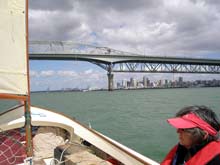
|
We were soon out of the narrow channel that leads to the marina, hoisting our sails and getting underway.
click images for larger views |
Dodging ferries and and other harbour users we soon sailed past North Head and the islands of the inner gulf came into view.
The first of these, Rangitoto Island is one of the most interesting. It erupted from the sea about 600 years ago, and the lava that spewed out formed an almost circular island with a very distinctive triple coned peak about 850 feet high. There is no volcanic activity now, and the island’s distinctive silhouette has become an iconic symbol of Auckland.
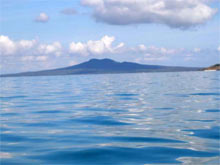 |
Rangitoto Island erupted from the sea about 600 years ago, and the lava that spewed out formed an almost circular island with a very distinctive triple coned peak about 850 feet high. |
It looks almost identical from any direction. Like many of the islands in the area, Rangitoto is administered by the Department of Conservation and is a wildlife sanctuary. It’s a fascinating place to wander around. When I first went there more than forty years ago it had large fields of bare black lava, fearsomely hot on a summer’s day, with patches of vegetation. It is now nearly completely covered with a unique Pohutukawa forest, and with the possums, deer and wallabies (all animals introduced from overseas) removed, it is flourishing. With the shallow draft of a Pathfinder, in settled weather we can get in amongst the reefs and rocks that surround the island, and have spent several nights camped aboard here, close enough to enjoy the lights of Aucklands suburbs sparkling across the channel, but far enough away to enjoy the solitude and and quiet of the night.
Today we had more distant objectives, and carried on to spend the night at Home Bay on the shores of Motutapu.This island is connected to Rangitoto by a causeway at Islington Bay; it is also a wildlife sanctuary and is being changed back from farmland to forest in an ambitious planting program that will continue for many years.
We anchored Varuna for the night, tucked in behind a tiny rocky islet near Home Bay and soon had the tent up and dinner on the stove. Barb served up another of her delicious one-burner meals, and as we sat and ate it we watched a rarely seen Reef heron foraging along the tideline as the daylight faded.
We were up early, to a fine day with light variable winds forecast. Up and away around 9 o’clock, we headed down Sergeant Channel and then Tamaki Strait, our objective for the day one of our favorite bays at the far end of Waiheke Island, about ten miles distant. We have stayed in Awawaroa Bay several times, and usually stop in it’s upper reaches, where there are quite large area’s of exposed tidal flats when the tide is not full. We usually anchor Varuna here and let her dry out on the mud flats, which abound with birdlife. This is what we did today, when we arrived in the early afternoon after a long hot sail on a sultry day of light breezes. We went ashore for a walk, and found Pied Stilts and Dotterals nesting on a shell bank above the high tide line. We were both very tired and spent a relaxing afternoon exploring the bay and reading and dozing in the sunshine. When Varuna refloated on the incoming tide soon after dinner, the wind had picked up again and was blowing directly into the area of the bay where we were, so we upped anchor and motored across to the anchorage that most visitors here use, tucked in close to shore and sheltered by the large hill on the headland at the Western entrance to the bay.
Another peaceful night aboard, and another beautiful day to greet us in the morning. With little wind likely until the afternoon, we set off after breakfast motoring towards the Waiheke Channel. We have sailed through here on several occasions, but have never had a close look at the many bays up this Eastern side of Waiheke Island, so this is what we planned to do. We motored slowly up the coastline where many of the bays are privately owned and have large houses with their own jetties and superb views of this beautiful area. At the northern end of the channel is Man O’War Bay, which is described in my cruising guide as ‘the perfect anchorage’. Well maybe, but not for us. There were dozens of boats already at anchor here, and, with a reasonable breeze now blowing down the channel we set off to find our own perfect anchorage in one of the little bays dotted down the Eastern coastline of Ponui Island. The Eastern side of Waiheke Channel is formed by three islands, Ponui, Rotoroa and Pakatoa. We sailed down between Pakatoa and Rotoroa Islands and on to Ponui. This coastline is foul with reefs and rocks, but between them are picturesque little sandy bays that are usually deserted. We found one to our liking not far past the Northern end of the island, and decided that we would spend the night here.
| As we entered the bay we dropped the anchor and then went ashore and tied the stern of the boat to a tree. Anchoring ‘fore and aft’ like this lets us move the boat up and down the beach as the tide ebbs and flows. |
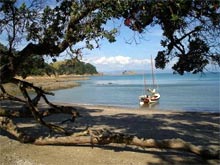 |
As we entered the bay we dropped the anchor and then went ashore and tied the stern of the boat to a tree. Anchoring ‘fore and aft’ like this lets us move the boat up and down the beach as the tide ebbs and flows, a technique we often use in situations like this. As night fell I positioned us a bit further out and then spent half the night fishing. It was a very dark night with moonrise well after midnight and the water was ablaze with phosphorescence. We had been trialing a lighting system I have made for the boat using LED cluster bulbs and had noticed on previous nights that the very bright anchor light acts as a magnet for fish and squid. I had a ball catching little fish for bait, and then trying to catch the larger snapper that were lurking on the bottom. No fish for breakfast though, the light gear I was using and lack of a landing net resulted in the larger fish I hooked breaking the line.
We had a much later start the next morning, and with no wind around we left the tent up and just motored a couple of miles further down the coast to another bay. This one had an inter-tidal reef just off a pebbly beach which we cruised along looking for a good place to land. I was standing on the transom to get a better look into the water when a huge black shadow passed under the boat. It was the largest stingray I have ever seen, maybe 5 or 6 feet across the wings and we watched in awe it as it ‘flew’ gracefully along the reef. This unnamed bay will always be ‘Stingray Bay’ for us.
| It was another perfect sunny day, and once again we anchored ‘fore and aft’ and went ashore for a brew up in the shade of one of the overhanging Pohutukawa trees. |
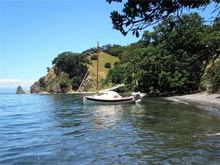 |
| As the tide dropped we let Varuna dry out high on the beach and spent the rest of the day soaking up more sunshine, exploring the shoreline out to the nearby point, and swimming in the warm water. Just another day in paradise. |
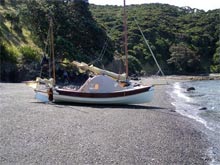 |
We refloated with the tide in the middle of the night and moved out into the bay, beyond the reef.
The following day was the 31st December, and over a leisurely late breakfast we discussed where we would like to be to see in the New Year. Having decided we needed more company than just our own on New Years Eve, and with the rubbish bag full, the fresh food finished and needing water, we looked out across the Firth of Thames to the Coromandel Peninsular 12 miles away, and the decision was made. Te Kouma harbour was bound to be full of boats and nearby Coromandel town would be open for business on New Years day, being a tourist mecca. There was the added attraction that it was all new territory for us. We set off about midday, hopeful that the forecast winds of 10 knots, rising to 15 later would eventuate. Unfortunately they didn’t. We motored most of the way across, baking in the sun, stopping to fish several times and sailing when the gentle breeze rose a little from time to time. We had got to within a couple of miles of Te Kouma, hot and tired, when we noticed a huge workup of gannets and other seabirds about half a mile away. The sea was boiling with fish and as we watched the action we noticed a large pod of dolphins heading our way. We started the motor and soon the dolphins joined us for a magical 20 minutes or so, playing around the bow and leaping out of the water. There were several babies with them, and for us the day was suddenly transformed. As they cruised alongside the boat they would turn on their sides to get a better view of us, obviously appreciating the beauty of a Welsford designed boat :-) With our spirits lifted, we cruised around the North side of the island that shelters the entrance to Te Kouma and into the harbour. This is the best anchorage along the whole Coromandel coast, a narrow harbour about two miles long and a quarter of a mile wide with several picturesque bays to choose between to anchor. The place was packed with boats, and not the sort of place we would normally choose to stay the night, but perfect for New Years Eve. The partying went on long into the wee small hours.
On New Years day we awoke to an Easterly breeze, a fine cloudy day and a late breakfast. A re-supply trip to Coromandel Town was on the agenda for high-tide just after mid-day, and the rising Easterly was also looking promising for a bit of exploration later among the many small islands dotted along the coast for a dozen miles northwards towards Cape Colville.
Coromandel has a large harbour, much of which is shallow. The town is tucked up in the NE corner, where there are extensive area’s of mudflats and mangroves. Shallow draft vessels can follow a narrow channel right up to the town for a couple of hours either side of high tide. Larger boats anchor off a mile or so, and use their tenders for the trip. The previous day someone had counted 58 ‘rubber ducks’ at the landing at high tide. It was nowhere near as busy when we got there, and proved to be a marvelous place to visit. The township itself was buzzing with holidaymakers and tourists. At the landing was a water tap and rubbish drop-off, directly across the road a petrol station, and just around the corner, 'The Coromandel Smoking Company’ famous for it’s amazing array of smoked fish. We visited them all, as well as the local supermarket. Tres convenient.
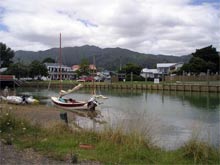 |
There were lots of places I’d like to try fishing, and a few spots where we could anchor in settled conditions, but we decided that would have to be another time, and headed back to spend the night in one of the other bays at Te Kouma. |
The easterly wind had freshened when we sailed away, taking the shortcut through Little Passage and then north up the coast towards the islands. It was a lovely sail, and we checked out all the nearer islands, looking for an overnight anchorage, and checking out the prospects for a subsequent trip. There were lots of places I’d like to try fishing, and a few spots where we could anchor in settled conditions, but we decided that would have to be another time, and headed back to spend the night in one of the other bays at Te Kouma.
With our time fast running out, it was back towards home the following day. The forecast was for the Easterlies to continue, which was what we needed, and we set out with high hopes of some more good sailing, but once again the wind did not play ball. We sailed a bit, fished a bit and motored quite a lot, but it wasn’t until we were most of the way across that wind finally started picking up. As we neared the Ruthe Passage between Rotoroa and Ponui Islands we found a good brisk breeze and had a very enjoyable sail from there back to the Western side of Ponui. The wind however had moved around a bit towards the North and when we got to the little bay where we had hoped to spend the night, it was blowing straight in there. There was nothing for it but to motor back across to Awaawaroa Bay, where we anchored in our favorite corner again and settled in for the night. The next morning was sunny and still, so once again it was Mr Honda to the rescue. We were about 25 miles from our starting point, and we ended up motoring the whole way. The outboard pushes us along at a steady 5.5 knots and the day was perfect for such a trip. There was just enough air movement to keep us a little bit cooler, and with silky smooth water and the islands along the way looking superb we just sat back and enjoyed it. We took the opportunity to explore the straight-line route which took us along the shore close to the Eastern Bays suburbs of Auckland, where there are several reefy outcrops to avoid. We usually travel the slightly less direct route out between the islands but this was a good opportunity to reacquaint ourselves with the channels and markers closer to shore. We reached the harbour bridge at noon, and by two o’clock we had Varuna out of the water and packed up ready for the short drive home.
We were both burnt brown by the days in the sun, and relaxed and ready to start the more mundane working life that makes our holidays possible. Other than a lack of wind sometimes, the weather had been perfect and the trip was voted a huge success by both of us. Our next trip away will probably be over Auckland’s Anniversary weekend, with a trip to the Mahurangi Wooden Boat Regatta. After that we are hoping to get away to the beautiful Bay of Islands, about 100 miles north of Auckland, for a week or two in late February. I for one can’t wait.
|

